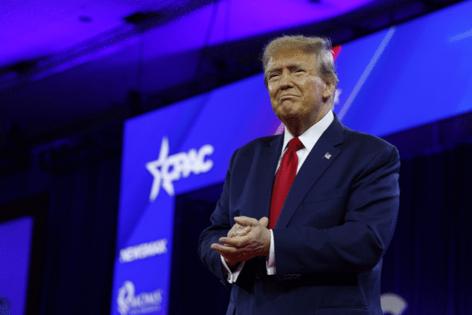Maryland shifted toward Donald Trump more than some other blue states, while giving Kamala Harris her second-biggest win
Published in Political News
BALTIMORE — When Lara Trump dropped by a Rockville country club for a fundraiser one week before Election Day, she exuded the kind of confidence that made even some of Donald Trump’s strongest local supporters turn their heads.
“She said we’re going to get over 300 electoral votes, we’re going to take both the House and the Senate and win the popular vote. And we all kind of looked at each other,” said one of those attendees, Montgomery County Republican Party Chairman Dennis Melby. “Darn it if she wasn’t right.”
Trump’s sweeping win — with 312 Electoral College votes and a popular vote lead of about 3 million — didn’t just reveal itself in the gains he made in swing states or reliably red areas of the country.
It showed up in places like deep-blue Montgomery County and in reliably Democratic states like Maryland.
Never considered anything close to a swing state, Maryland was on track to give Democrat Kamala Harris her second-biggest win in the country four years after it gave President Joe Biden his third-biggest win ––– behind Vermont and Massachusetts in 2020 and only Vermont this year.
But like those and other Democratic strongholds, Maryland still shifted toward Trump.
It was not only among the 19 states that Harris won, but still moved in Trump’s direction; it is on track to shift slightly further than most of them.
The latest available results show Trump improving on his 2020 margin by 7 percentage points in Maryland and by an average of 5.5 percentage points in other blue states. The shift was, on average, slightly more in states that gave Biden his biggest wins, and it was smaller in swing states where Harris spent almost all of her time campaigning, according to The Baltimore Sun’s review of the latest results as states continue to process ballots.
That marginally heavier shifts toward Trump in more Democratic areas was reflected in Montgomery County, the largest county in Maryland and home to the most registered Democrats. Unofficial results show Harris with a major win there, capturing 74% of the vote. Still, her winning margin over Trump was 8.3 percentage points less than Biden’s, one of the largest changes in the state. Democrats are still reckoning with why.
‘A lot of soul searching’
Maryland Democratic Party Chairman Ken Ulman said he wasn’t surprised to see the county move in a way that mirrors the shift in other blue states, even if he can’t pin down the exact reasons for it.
“Montgomery County is a very large county, a very diverse county in every way, and folks in the county are dealing with the same issues that folks in other parts of the country are dealing with,” said Ulman, a former top elected official in Howard County.
Melby, the Montgomery County GOP chairman, said he believes the Lara Trump fundraiser was the only official Trump campaign event in the county this year, and it raised about $200,000 with roughly 100 people in attendance.
His 45-member committee held other events, and it handed out 40,000 sample ballots to voters who he said were more amenable than they previously had been to getting information about Republican candidates. The economy and illegal immigration were the biggest concerns he heard, including from members of the county’s robust immigrant community.
“They kind of wrote off Montgomery County,” Melby said of the Trump campaign, “but we worked really hard.”
Ulman said he was proud of how Democrats performed, especially with wins across the board in competitive races like the U.S. Senate matchup between Democrat Angela Alsobrooks and Republican Larry Hogan, and the 6th Congressional District race where Montgomery County helped carry Democrat April McClain Delaney over the finish line.
But he said the shifts toward Trump in Maryland and elsewhere require deep conversations about what happened and what the party needs to move forward. In his view, that means communicating with voters in a better way that makes it clear how policy improves their lives.
“There’s a lot of soul searching, a lot of looking in the mirror and thinking what messages we need to lean into and what messengers we need to lean into those messages,” Ulman said.
What do the shifts toward Trump in blue states mean for future elections?
John Willis, a University of Baltimore professor and former secretary of state under former Democratic Gov. Parris Glendening who closely tracks election data, said the presidential result in Maryland shouldn’t be considered the new normal.
“Harris’ performance is one of the best in the last half-century,” Willis said, stressing that quick reactions and analysis never explains the full picture.
“One election’s not a trend. Two elections is not a trend,” Willis said. “You need to do 20 years to get a trend and I don’t see anything like that.”
Matthew Levendusky, a University of Pennsylvania political science professor, said “it’s very hard to say” what the shifts in blue states mean for future elections.
Though there were signs in recent years that Republicans were gaining momentum, the new gains may reflect a pretty straightforward economic trend, he said. He noted many of the blue states where Trump did better have a higher cost of living, making residents there more likely “to feel the pinch of inflation.”
“We did see a bit of a foreshadowing of this in 2022, when we saw Republicans do much better than expected in California and New York,” Levendusky said. “But it’s still difficult to disentangle a bigger trend from the fact that all voters swung toward Trump, due in no small part to the economy.”
Poor turnout in heavily Democratic cities also appears to have contributed to the slump, at least according to the still incomplete results, Levendusky said.
“Whether this will still be true once we have the full data will be an important story to watch in the years to come,” Levendusky said.
But even if some Democrats are re-evaluating nearly every aspect of their approach, it’s important to note where Democrats still also had success, Levendusky said.
The six swing states that flipped back to Trump did so at smaller margins, on average, compared to states that backed Harris. Trump improved in those states by an average of 3.8 percentage points — less than the 5.5 percentage point swing on average for the states Harris won.
That allowed for some key wins for Democrats trying to block Republicans from having an overwhelming new majority in the U.S. Senate. Republicans gained four seats, giving them control with 53 seats, but Democratic Senate candidates won in four of the swing states that went for Trump — Arizona, Michigan, Nevada and Wisconsin.
Hogan stands out as ‘Republicans’ top overperformer,’ but Maryland is still a blue state
That kind of ticket-splitting — where a number of voters picked a Republican for president and Democrats for other offices — went the opposite way in Maryland, where Harris handily won the state and Hogan outperformed Trump.
Hogan secured about 236,000 more votes than Trump, and Democrat Angela Alsobrooks won the race with about 230,000 votes less than Harris. In every county in the state, Hogan won a higher percentage of the vote than Trump, and Alsobrooks won less than Harris, by an average of about 8 percentage points.
Hogan “stood out as Republicans’ top overperformer” out of all the Senate elections in the country, according to an analysis published Thursday by the University of Virginia’s Center for Politics.
The Republican’s campaign touted that thought in its post-election analysis Thursday, with strategist Russ Schriefer writing to supporters that Hogan “expanded the tent and brought voters to the polls.” The campaign blamed his loss — which, at 10 percentage points, was the closest any Maryland Republican has come to winning a U.S. Senate seat in more than four decades — on “national factors and a false narrative” that control of the Senate would come down to the race.
Alsobrooks had made that pitch herself for months, though it was increasingly clear that Republicans would tip the scales by winning in a few other states. Schriefer wrote that the Hogan campaign’s own internal polling showed almost 80% of Alsobrooks’ voters picked her so that Democrats could keep control of the Senate.
“Our polling also showed that this message had already sunk in by early June — suggesting media coverage about Senate control played a bigger role than paid advertising in shaping voter perceptions,” Schriefer wrote.
Ulman, the Democratic leader, said the message resonated because it’s what voters wanted. Despite Hogan’s performance and Trump’s gains, Maryland is still blue, after all, he said.
“We knew that was a powerful message because, frankly, Maryland’s a Democratic state,” he said.
---------
©2024 The Baltimore Sun. Visit at baltimoresun.com. Distributed by Tribune Content Agency, LLC.




























































Comments